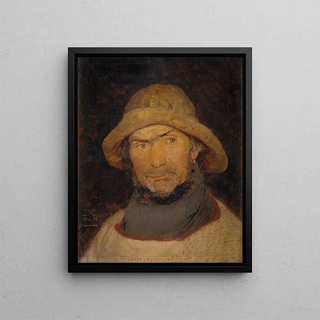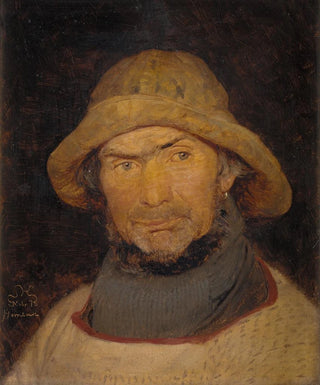Art print | Portrait of a Fisherman from Hornbæk - Peder Severin Krøyer


View from behind

Frame (optional)
In the fascinating world of art, some works manage to capture the very essence of humanity through simple yet evocative scenes. The "Portrait of a Fisherman from Hornbæk" by Peder Severin Krøyer is one of these creations. This painting, depicting a man with a deep gaze and contemplative expression, immerses us in Denmark's maritime universe at the end of the 19th century. The piece, both intimate and universal, invites reflection on the lives of fishermen, their daily routines, but also on human nature and its relationship with the environment. Through this portrait, Krøyer does not merely depict an individual; he evokes a story, a culture, and a way of life in transition.
Style and uniqueness of the work
Krøyer's style, emblematic of the Scandinavian Impressionist movement, is distinguished by its ability to play with light and color. In the "Portrait of a Fisherman from Hornbæk," shades of blue and gray dominate, evoking the sea and sky, while brighter touches highlight the fisherman's facial features. This subtle play of light, which seems almost to dance across the canvas, gives the artwork an atmosphere that is both serene and melancholic. The composition, centered on the figure, immediately draws the eye and encourages us to explore the details of his expression. The realism of the depiction, combined with a certain poetry, demonstrates the artist's technical mastery. Krøyer thus manages to create an emotional connection between the viewer and the subject, making the work all the more captivating.
The artist and his influence
Peder Severin Krøyer is one of the major figures of Danish art, and his work has had a significant impact on the Scandinavian artistic scene. A member of the "Skagen painters" group, he was able to capture the light and landscapes of Northern Europe with a unique sensitivity. His innovative approach to painting, blending realism and impressionism, paved the way for many artists of his generation. Krøyer was also a keen observer of

Matte finish

View from behind

Frame (optional)
In the fascinating world of art, some works manage to capture the very essence of humanity through simple yet evocative scenes. The "Portrait of a Fisherman from Hornbæk" by Peder Severin Krøyer is one of these creations. This painting, depicting a man with a deep gaze and contemplative expression, immerses us in Denmark's maritime universe at the end of the 19th century. The piece, both intimate and universal, invites reflection on the lives of fishermen, their daily routines, but also on human nature and its relationship with the environment. Through this portrait, Krøyer does not merely depict an individual; he evokes a story, a culture, and a way of life in transition.
Style and uniqueness of the work
Krøyer's style, emblematic of the Scandinavian Impressionist movement, is distinguished by its ability to play with light and color. In the "Portrait of a Fisherman from Hornbæk," shades of blue and gray dominate, evoking the sea and sky, while brighter touches highlight the fisherman's facial features. This subtle play of light, which seems almost to dance across the canvas, gives the artwork an atmosphere that is both serene and melancholic. The composition, centered on the figure, immediately draws the eye and encourages us to explore the details of his expression. The realism of the depiction, combined with a certain poetry, demonstrates the artist's technical mastery. Krøyer thus manages to create an emotional connection between the viewer and the subject, making the work all the more captivating.
The artist and his influence
Peder Severin Krøyer is one of the major figures of Danish art, and his work has had a significant impact on the Scandinavian artistic scene. A member of the "Skagen painters" group, he was able to capture the light and landscapes of Northern Europe with a unique sensitivity. His innovative approach to painting, blending realism and impressionism, paved the way for many artists of his generation. Krøyer was also a keen observer of






